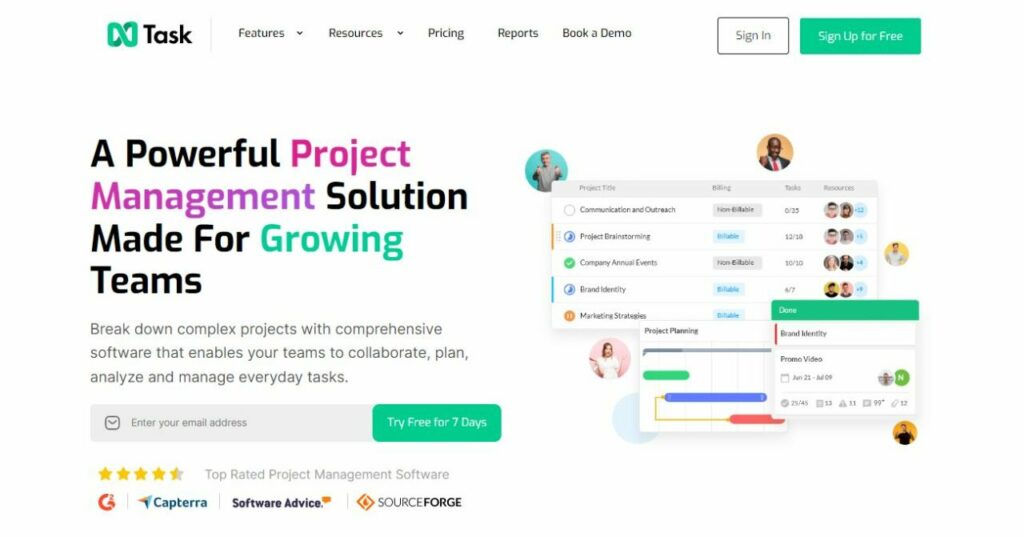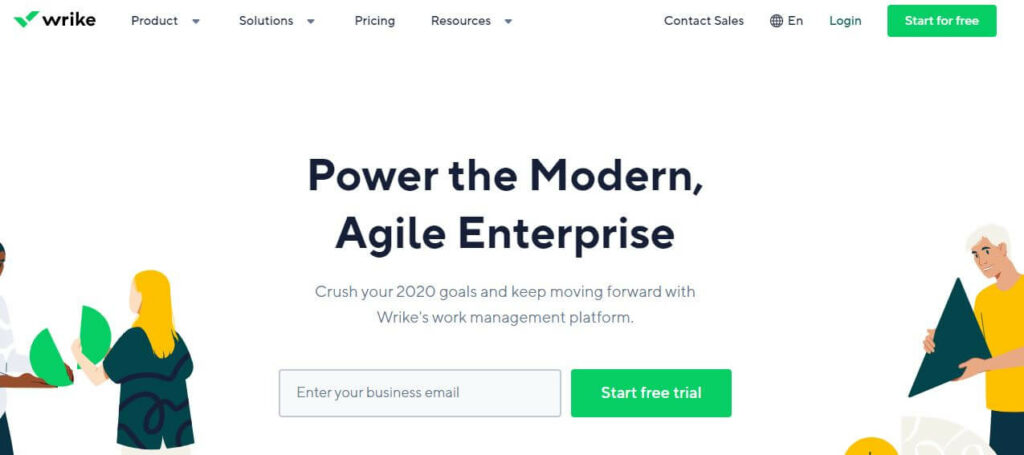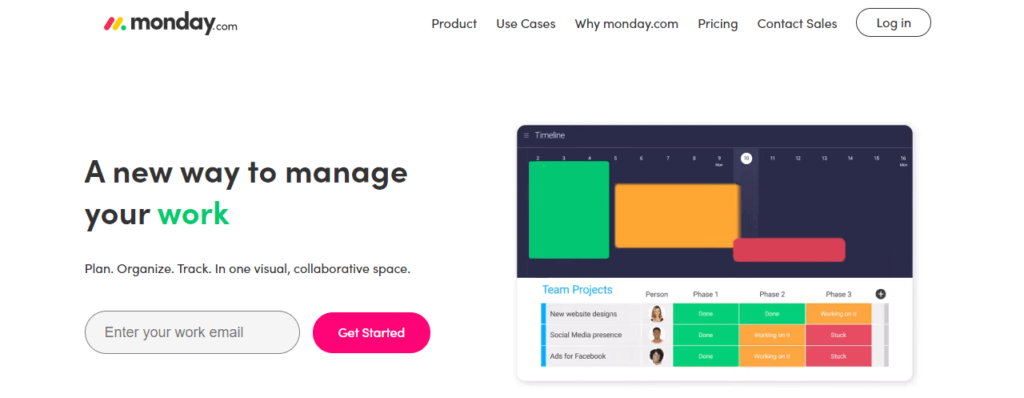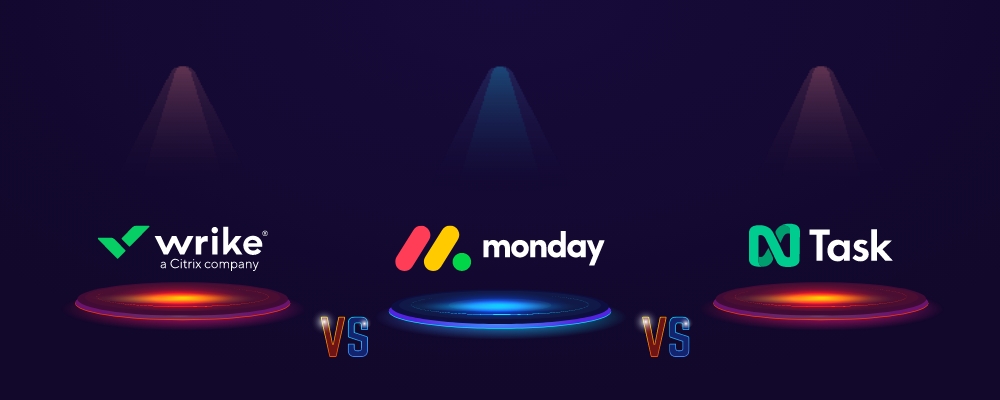Trying to juggle your team’s projects and tasks? The battle of the project management platforms is here to help!
In this blog, we are going to compare Wrike vs Monday vs nTask and find out all of the features and benefits associated with these applications. Stay tuned to Find out which one will give you the best bang for your buck!
What Are Project Management Platforms?
Project management platforms are software solutions designed to help project managers and their teams track tasks, resources, and time.
They provide a comprehensive suite of tools for teams of all sizes, from small startups to large enterprises. With project management platforms, users can assign tasks and manage workloads on a single platform.
Simplify project management
with nTask today!

They also allow for collaboration among team members so that everyone can stay on the same page with projects.
The platform helps ensure that deadlines are met and tasks remain organized by providing real-time updates, task tracking systems, automated emails when changes occur in the timeline or the budget.
Project management platforms also allow users to store project data securely in the cloud and access it anytime they need it from any device.
By using these platforms, businesses can save time managing projects by eliminating manual processes such as email checking or manual task status updates as well as eliminate errors associated with miscommunication over multiple channels.
Importance Of Choosing The Right Platform For Your Project Management Needs?
Choosing the right platform for project management needs is essential to success. It requires careful consideration since this decision can impact a project’s timeline, budget, and overall outcome.
The platform chosen should be tailored to the organization’s specific requirements such as its size, culture and the nature of projects being managed.
It should also be user-friendly and have features that make managing tasks easier for everyone on board. Additionally, scalability is important in order for it to grow with your business as you need more complex solutions over time.
Project management platforms come with various features that allow teams to collaborate efficiently, assign tasks quickly and track progress in real-time.
This improves communication between team members while providing visibility into where resources are being utilized across departments or external partners effectively.
Some platforms offer additional features such as automated reminders or templates which reduce manual data entry or manual processes involved in creating reports which increase efficiency even further.
Moreover, it helps organizations stay organized when managing large projects with many moving parts and stakeholders involved by providing a digital centralized hub for all related information including documents, discussions and task assignments held in one place.
When choosing a platform for your project management needs make sure it meets all of your current requirements but allows sufficient flexibility so you are not locked into just one type of technology if other solutions become available later on down the line.
Furthermore, ensure that there is technical support available from vendors whenever needed. Regardless of what type of project you’re working on, selecting a robust yet user-friendly software system will set you up for success down the road.
Benefits Of Using Project Management Solutions?
1. Streamline Collaboration: Project management solutions are designed to promote collaboration and information sharing among employees, allowing teams to work together efficiently on projects without having to gather in the same place. Services range from document collaboration platforms to online project workspaces that integrate task management, communication tools, file storage systems, project scheduling software and more.
2. Increase Visibility: With a project management system in place, leaders have access to real-time reporting so they can accurately monitor team performance and make better decisions quickly when needed. This visibility also helps foster accountability and eliminates miscommunication issues between teams or departments across an organization.
3. Lower Costs: Utilizing project management technology can minimize the costs associated with delays or mistakes by helping ensure that tasks are completed on time as well as eliminating costly manual processes such as photocopying documents for distribution or tracking progress spreadsheets instead of using automated dashboards which provide deeper insights into a project’s status at any given point in time.
4. Improved Efficiency: When used effectively, comprehensive project management tools help automate activities like task monitoring, problem resolution tracking and decision making while also providing necessary resources needed for successful completion of goals within budgeted timelines – resulting in increased efficiency gains over traditional methods of managing projects manually each step of the way.
Project Management Methodologies
Project management methodologies are the systematic approaches used to manage projects in a structured and organized way.
These methods ensure that each project is carried out efficiently and effectively, while also helping to improve overall project success.
Common project management methodologies include Waterfall, Agile, Lean methodology, Critical Chain Project Management (CCPM), Test Driven Development (TDD) and Matrix Project Management.
Waterfall is one of the most popular methods of project management as it provides a step-by-step approach to managing projects effectively.
This involves setting objectives for each stage of the process and then working your way through them sequentially until all aspects are completed successfully.
The Agile methodology works on an iterative cycle whereby new increments or versions are released frequently based on feedback from stakeholders or customers about which features need improvement or elimination.
Wrike Vs Monday Vs nTask
nTask

nTask task management software is an essential tool for anyone dealing with multiple tasks at once.
It keeps track of your tasks and makes sure they’re completed on time, while also providing reminders, reports, and other features to make managing projects even easier.
With this software, users can stay organized and prioritize their important tasks faster and more efficiently. The user-friendly interface helps ensure that all necessary information is easily accessible.
Additionally, nTask task management software allows users to customize the way they track their tasks by setting deadlines, delegating responsibilities, auto-scheduling meetings, tracking progress against objectives and generating reports for review.
The streamlined design makes it easy to view a project’s progress in one place without needing to jump from page to page.
Overall, nTask task management software helps you manage your workload better so that you can deliver the best results with fewer hassles than before.
Features
1. Dashboard: Provides a centralized view of all current tasks and upcoming deadlines, with an easy-to-read graphical representation of workloads.
2. Task Assignment: Allows users to assign tasks to team members, set deadlines, and monitor progress quickly and easily.
3. Notifications: Automated notifications alert users when a task is assigned or updated so that everyone stays on the same page from start to finish.
4. Collaboration Tools: Users can comment, attach files, or tag other team members within specified tasks to ensure collaborative projects are completed efficiently and accurately.
5 Reports & Analytics : Generates valuable reports and insights on project performance to improve productivity in the future.
Pros
• Streamline organizational processes with automated task and project tracking.
• Monitor project performance in real-time with detailed analytics.
• Configure custom workflows and set reminders to ensure deadlines are met.
• Promote collaboration by enabling team members to share task updates in one place.
• Automatically generate reports on task completion, overdue tasks, and more.
Cons
- Task management software can be confusing and overwhelming, lacking in user friendly features.
- Task management software may lack key features for certain business processes or operations.
- The cost of purchasing a task management system can be prohibitively expensive for small businesses.
- Software installation, maintenance and upgrading can require significant technical effort and resources.
- Cross platform compatibility issues mean that some tasks are not supported on certain operating systems or platforms.
Pricing
- Pro $3/month
- Business $8/month
- Enterprise Custom/month
Rating
- 4.7,4.4
Wrike

The Wrike task management system is an incredibly powerful platform for keeping projects and teams organized.
It offers a comprehensive suite of features that make it easy to manage tasks, assign work, collaborate with team members, track progress, set deadlines, and provide feedback.
With the ability to assign tasks to specific members or teams of people, delegate responsibility for certain tasks, store files securely in the cloud for collaboration and access from anywhere, and create custom labels and tags for better organization of tasks and documents.
The Wrike dashboard also provides a clear overview of all project activities so everyone can stay on track.
Its intuitive design makes it simple to get started quickly with minimum effort while giving organizations full control over how they organize their workflows.
With valuable reporting tools available as well as integrations with popular apps like Slack and Google Drive; this system offers something for everyone from small business owners to global enterprises alike.
Features
- Task Organization: Wrike’s task management system allows users to intuitively organize tasks into different folders, subfolders and workspaces for maximum efficiency. Users can also prioritize tasks by assigning specific attributes, such as labels, deadlines and statuses.
- Real-Time Communication: In addition to task organization tools, Wrike’s communication features keep team members connected throughout the duration of a project. Users can start conversations within any task directly from the platform and can send notifications when something changes or an update is needed.
- Time Tracking: Built-in time tracking within Wrike enables teams to accurately monitor how long they are working on each task and project without having to switch between multiple applications or manually calculate hours through spreadsheets.
- Integrations & Automation: Integrating with third-party services like Google Calendar or Zapier helps streamline workflows across all aspects of a business while automation capabilities allow some processes―such as setting up recurring activities―to run more efficiently without additional input..
- Reporting & Analytics: With real-time reports and detailed analytics, teams have insights about their performance over various periods of time that help inform future decision-making in order to improve productivity going forward
Pros
• Wrike enables seamless collaboration and communication for remote teams by providing an intuitive platform for task management, file sharing, and project organization.
• It allows users to customize workspace layouts and activities to fit their specific needs.
• Utilizing advanced color coding technology, tasks are easily visible in the calendar view allowing team members to track progress at a glance.
• Automation tools help save time with recurring checklists, workload allocation, and reports.
• The intuitive interface is easy to use even for those who may not be tech-savvy.
Cons
- Wrike task management system is not well suited for complex projects as it does not allow for assigning priorities.
- The user interface can be clunky and difficult to navigate in some cases.
- Wrike task management system does not offer a wide range of customization options, which may limit its usefulness to organizations with particular needs.
- It can be difficult to find the information you need in the large amount of data that is stored within the system.
Pricing
- Free $0/month
- Team $9.80/month
- Business $24.80/month
- Enterprise Custom/pricing
- Pinnacle Custom/pricing
Ratings
- 4.2, 4.1
Monday.com

Monday.com is a project management platform designed to help teams capture, organize and prioritize their work in order to increase efficiency and collaboration.
It offers an intuitive user interface that allows users to create projects, assign tasks, monitor progress, track time, collaborate with team members and more.
With its customizability features such as templates, dashboards and reporting capabilities it can be tailored specifically for any business or organization’s needs.
This makes it easy for users of all levels of technical experience to use the platform effectively. The platform also integrates with other popular software applications like Google Drive, Dropbox and Salesforce for added convenience.
Additionally, Monday.com provides notifications on task progress so that everyone stays informed about relevant updates from their colleagues or partners working on the same project.
Further enhancing its robust feature set is its strong security protocol which ensures the safety of sensitive data stored within the system while maintaining privacy rights compliance across jurisdictions around the world.
Features
- Task Management: Create tasks in different boards, drag and drop them between columns and assign team members or progress levels to the tasks. Track progress through task completion rates, activity calendars or timelines. Additionally, set due dates or recurring tasks with automated reminders and notifications.
- Team Collaboration: Add comments to each task so teams can communicate in one place regarding the status of their project. Create custom views on a board for different team members as well as assign specific privileges for each member’s access level on the board.
- Project Tracking: View reports that summarize all projects’ statuses at once in order to check goals achieved against objectives defined from the beginning of the project’s timeline; view resources used including time spent by team members across multiple projects.
- Integrations & Automations: Connect with third-party integrations such as Jira, Slack, Dropbox etc., which seamlessly merges data into Monday’s platform for easy tracking; automates processes like setting repeatable reminders about upcoming milestones or deadlines without manual intervention from users.
Pros
• Easily customizable interface for team collaboration and project tracking.
• Ability to organize projects with tasks, subtasks, due dates, labels and comments which are accessible from anywhere on any device.
• Calendar view helps to prioritize tasks and ensure nothing is missed.
• Automate processes further with rules that can trigger notifications or set task statuses automatically when certain conditions are met within the project.
• Seamless integration with other tools like Dropbox and Slack for a unified workspace.
Cons
- Monday.com is a comprehensive project management platform that allows users to easily track progress, assign tasks, and collaborate with team members in one convenient location.
- The platform offers powerful features such as task creation, timeline visualization, Kanban boards and more.
- It also includes an intuitive user interface so teams can quickly get up to speed on the software and start managing their projects more efficiently.
- Additionally, Monday.com provides robust analytics capabilities that give teams insight into project performance and help them identify potential areas for improvement.
Pricing
- Individual $0/month
- Basic $9/month
- Standard $12/month
- Pro $19/month
- Enterprise custom/month
Ratings
- 4.4, 4.6
What Is The Best Platform For Your Project Management Needs – Monday Vs. Wrike Vs. nTask
nTask is a leading project management platform for individual users, teams, and businesses of all sizes. The platform offers an intuitive interface, robust project management features and extensive integration capabilities.
nTask makes it easy to create and track tasks, assign workflows, visualize progress with Gantt charts, manage resources using Kanban boards, and collaborate with team members in real time on projects or tasks through the helpdesk feature.
It gives you the ability to create detailed timelines for your projects which are visible at every level of your organization so that everyone can stay up-to-date with the current status of a project.
It also has an integrated file-sharing feature which allows you to store files directly in nTask or link them from other cloud storage services such as Dropbox or Google Drive.
You can even attach comments or screenshots directly within tasks so that everyone knows what is going on.
nTask also includes powerful custom reporting tools that enable you to easily generate reports on any aspect of your projects including progress updates from team members and financial reports showing how much time each person spent working on specific tasks during certain periods of time.
Additionally, nTask provides automated reminders via email when someone is assigned tasks that are due and automatically sends out notifications when a task has been completed successfully or moved from one phase to another along its workflow timeline.
Conclusion
Ultimately, the project management platform that best fits your needs depends on the type of projects you are managing and the size of your team.
Wrike is a great choice for large teams with complex projects, while Monday is better suited to smaller teams with shorter-term tasks.
nTask offers an easy-to-use interface and budget-friendly pricing structure that make it ideal for individual or small teams who need a basic task list application.
No matter which option you choose, all three platforms provide reliable solutions to help manage and keep track of your projects.
FAQs
What are the challenges facing project management?
Additionally, budget constraints can play a role in limiting the resources available for successful project execution, while unexpected events such as illness or delays can throw timelines off course. All these considerations require careful planning and expert oversight in order to address any potential issues before they become an insurmountable problem for the project’s completion.
What is the most challenging part of project management?
It also requires an understanding of how to manage stakeholders in order to ensure that all parties are informed and on board with the desired outcomes. Additionally, it is also important to be aware of budget constraints while still striving for a successful completion of the project.

